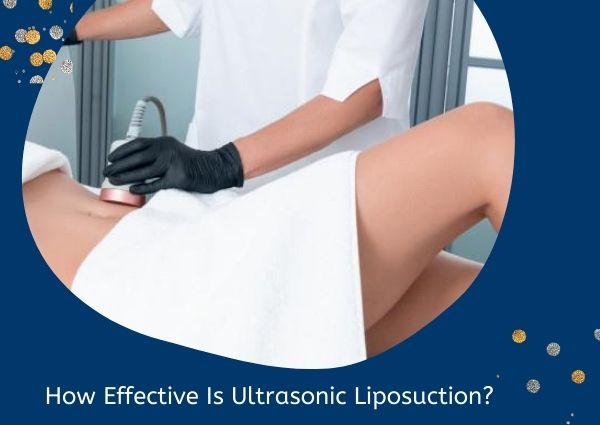How Effective Is Ultrasonic Liposuction?

How Effective Is Ultrasonic Liposuction?
In the following we will be discussing about an important topic that is “How Effective Is Ultrasonic Liposuction?” lets discuss about it thoroughly within the article:Ultrasonic liposuction is actually a sort of fat loss procedure that liquefies fat cells before their removal. This is actually done with the guidance of an ultrasound combined or mixed with ultrasonic waves to simply target or focus on fat cells. This type of cosmetic surgery is also referred to as ultrasound-assisted liposuction (UAL).
Overview
Liposuction is the most common type of aesthetic procedure performed in the United States. While the purpose is to get rid of fat and sculpt your body, liposuction isn’t intended for weight loss. Instead, the procedure can remove smaller areas of fat deposits that are difficult to target with diet and exercise.
What Are The Benefits
UAL is sometimes used in place of suction-assisted liposuction (SAL). While SAL is the oldest and most tried-and-true version of this surgery, it has some limitations that UAL seeks to fill. It has the added benefits of:
- more precisely removing fat
- getting rid of stubborn fibrous fat, or “fat rolls”
- increasing skin contraction
- preserving surrounding nerves
UAL may also reduce surgeon fatigue, because it liquefies the fat before it’s sucked out. This may actually provide better results for people undergoing the procedure or treatment.
What Are The Risks
While UAL is actually a more precise sort of liposuction, there are a couple of downsides to this cosmetic procedure. First, there’s a greater risk of scarring compared to SAL. Skin loss, abdominal holes as well as nerve damage are also quite possible. There’s also a risk of infection — just as with any type of surgery.Another possibility is the development of seromas. These are fluid-filled pockets that can actually develop where liposuction takes place. They are actually a result of a combination of old blood plasma as well as dead cells exiting the body from the lipoplasty.
One review of 660 UALs found other side effects, too. The following effects were reported:
- three cases of seromas
- two reports of hypotension (low blood pressure)
- three cases of contact dermatitis (eczema rashes)
- one report of hemorrhage
The Mayo Clinic doesn’t recommend liposuction for people with the following:
- a weakened immune system
- coronary artery disease
- diabetes
reduced blood flow
What To Expect
Your surgeon will provide you with some instructions prior to the procedure. At this appointment, ensure you tell them about all supplements and medications you take. They will quite likely ask you to stop taking any sort of blood-thinning drugs — including ibuprofen (Advil) — many days before your surgery.UAL may be utilized in the following areas of the body:
- Abdomen
- Back
- Breasts
- Buttocks
- Lower extremities (legs)
- Upper extremities (arms)
Most UALs are done on an outpatient basis. You can actually expect to have the surgery in a medical office and even go home the same day. If your surgeon is covering a large or wider area, they may actually conduct the procedure or treatment at a hospital instead.
Depending on coverage, your surgeon will use either local or even topical anesthesia to numb the target area. Once the anesthesia kicks in, your surgeon will then insert a rod into your skin which will further deliver ultrasonic energy. This destroys the walls of fat cells and liquefies them. After the liquification process, the fat is actually removed by a suction tool known as a cannula.
Recovery Timeline And When You’ll See Results
Recovery from UAL is actually relatively brief compared to the results timeline. Since this is generally an outpatient procedure or treatment, you’ll actually be able to go home right away if you don’t have any side effects. You may actually need to take a couple of days off school or work to rest.Your doctor may recommend moderate exercise, like walking, within a couple of days of the procedure. This helps keep your blood flowing, so blood clots don’t develop. If you have swelling, you’ll wear compression garments.
It’s important to keep in mind that UAL won’t get rid of cellulite. If this is your goal, you may want to consider other procedures.According to the American Society for Dermatologic Surgery (ASDS) may actually not really see full results for many months. The association also says that UAL has the quickest recovery time compared to other kinds of liposuction. Swelling and other mild side effects usually subside after a couple of weeks.
What You Can Expect To Pay
Liposuction is considered a cosmetic procedure. Therefore, medical insurance is unlikely to cover this sort of surgery.You may actually consider talking to your doctor about a payment plan. According to the American Society of Plastic Surgeons the average liposuction costs is estimates to be around $3,200. Costs may vary depending on the area being treated, as well as whether you actually require hospitalization.
Is It Effective?
Satisfaction was actually determined by overall fat loss as well as weight loss maintenance. However, the authors of the same study actually found that about 35% ended up gaining weight. Much of these gains happened within the 1st year of the procedure. The authors recommend lifestyle counseling before and after UAL to assist prevent weight gain.
